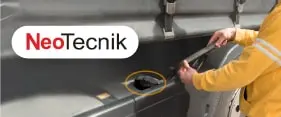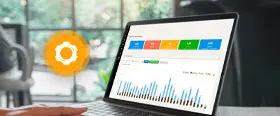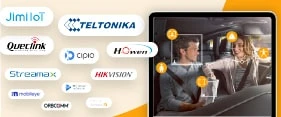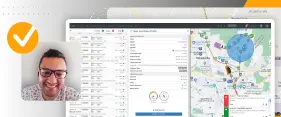GPS tracking is a technology that allows you to know the exact location of any asset connected to the system. For reasons of security, as well as for resource optimization and business, real-time GPS tracking systems are essential for logistics today.
Real-time monitoring of vehicles and control over distribution routes allows for the optimization of most logistical processes. Which aspects of the business benefit? All of them:
- Route planning.
- Customer service.
- Last-mile deliveries.
You may have some common questions: Do you know how this technology works? What benefits does it provide, and how do you choose the best platform? Find the answers below.
Table of Contents:
1. How Does GPS Satellite Tracking Work?
2. Key Benefits of GPS Tracking
3. How to Determine Which Platform is Best for Your Company.
4. Conclusion
How Does GPS Satellite Tracking Work?
A GPS tracking system operates based on three components:

- Hardware: GPS tracking devices located on the assets to be tracked.
- Connectivity: The network or medium through which the information generated by tracking devices is transmitted.
- Software: It interprets the received information, decodes it, and displays it through a graphical interface (UI).
By combining these components, you obtain the exact and real-time location of each device, utilizing telemetry techniques. This allows for effective tracking and monitoring.
Key Benefits of GPS Tracking:
Telemetry (remote measurement of quantities and the transmission of that information to interconnected devices) is currently essential in logistics. It greatly contributes to service quality, improves business productivity, and optimizes management times.
Implementing a comprehensive solution that takes into account the company, drivers, and fleet is one of the resources that add value to logistics. In this sense, GPS tracking provides several solutions and benefits for fleet management:

Reduces thefts:
Real-time GPS tracking allows you to know the exact and live location of assets at any time. Together with alert solutions, such as geofencing and georouting, it is designed to prevent theft.
For example, by configuring geofences, if vehicles or assets move unexpectedly (beyond the selected perimeter), an automatic alert is triggered.
With this information, the tracking team can take measures to prevent the incident.
Shares real-time locations with customers:
Providing customers with real-time GPS location and estimated arrival times (ETAs) is key to customer satisfaction. Sharing GPS location updates allows customers to track vehicles in real-time and know when the driver will arrive at their destination.
Providing this information not only helps reduce the uncertainty and anxiety associated with waiting but also increases trust in the company and, consequently, brand loyalty.
Reduces operating costs:
Measuring driving style or habits significantly impacts fleet operating costs. For example, vehicle wear and the risk of accidents depend on how a vehicle is driven.
It is possible to optimize costs by monitoring and analyzing factors such as:
- Distance traveled
- Unjustified route changes
- Fuel consumption
- More frequent maintenance and shorter vehicle lifespan
Performing timely maintenance also allows for the rescheduling of operational activities without affecting customers and avoids the risk of potential vehicle damage or malfunctions.

Controls moving assets:
It is possible to visualize the entire fleet's route and ensure that assigned tasks have been completed. Additionally, with GPS tracking, alerts, notifications, and events can be configured to ensure that everything is going according to plan.
If a compliance alert is triggered, it is possible to make real-time corrections or obtain later reports with measurable data on incidents or successes in operation.
Increases productivity:
Satellite tracking detects practices that cost a company money. For example, it allows fleet managers to see if planned routes are being followed or if they are inefficient and require redesigning.
Similarly, if a vehicle is used for purposes other than intended or if drivers adhere to designated work hours, updated information enables more effective decision-making.
All of this translates into a positive return on investment for the company because it increases employee productivity and optimizes available resources.
How to Determine Which Platform is Best for Your Company?
The answer is simple: it depends on the data you want to obtain regarding your business's key performance indicators (KPIs) and the platform's usability.
Therefore, when making a decision, the primary consideration should be an analysis of each company's needs and requirements.
Conclusion
GPS satellite tracking reduces costs and optimizes the allocation of logistics resources. It also increases fleet and personnel productivity.
This is possible through real-time monitoring of vehicles and control over distribution routes.
In summary, implementing a GPS tracking system addresses five crucial aspects related to assets. Do not hesitate to incorporate this technology into your improvement strategies and start enjoying the benefits.









